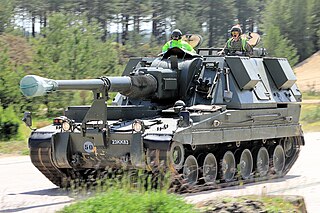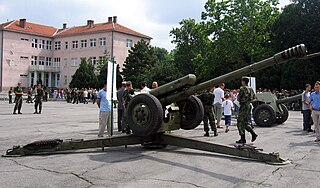
The 8 inch (203 mm) M110 self-propelled howitzer is an American self-propelled artillery system consisting of an M115 203 mm howitzer installed on a purpose-built chassis. Before its retirement from US service, it was the largest available self-propelled howitzer in the United States Army's inventory; it continues in service with the armed forces of other countries, to which it was exported. Missions include general support, counter-battery fire, and suppression of enemy air defense systems.

The AS-90, known officially as Gun Equipment 155 mm L131, is an armoured self-propelled artillery used by the British Army.

Nuclear artillery is a subset of limited-yield tactical nuclear weapons, in particular those weapons that are launched from the ground at battlefield targets. Nuclear artillery is commonly associated with shells delivered by a cannon, but in a technical sense short-range artillery rockets or tactical ballistic missiles are also included.

The 2S1 Gvozdika is a Soviet self-propelled howitzer introduced in 1972 and in service in Russia and other countries as of 2023. It is based on the MT-LBu multi-purpose chassis, mounting a 122 mm 2A18 howitzer. "2S1" is its GRAU designation. An alternative Russian designation is SAU-122, but in the Russian Army it is commonly known as Gvozdika. The 2S1 is fully amphibious with very little preparation, and once afloat is propelled by its tracks. A variety of track widths are available to allow the 2S1 to operate in snow or swamp conditions. It is NBC protected and has infrared night-vision capability.

The Panzerhaubitze 2000, meaning "armoured howitzer 2000" and abbreviated PzH 2000, is a German 155 mm self-propelled howitzer developed by Krauss-Maffei Wegmann (KMW) and Rheinmetall in the 1980s and 1990s for the German Army. The PzH 2000 has automatic support for up to five rounds of multiple round simultaneous impact. Replenishment of shells is automated. Two operators can load 60 shells and propelling charges in less than 12 minutes. The PzH 2000 equips the armies of Germany, Italy, Ukraine, Netherlands, Greece, Lithuania, Hungary, Qatar and Croatia, mostly replacing older systems such as the M109 howitzer. In November 2019, a PzH 2000 L52 gun fired a shell a distance of almost 67 km. As of 2020, a prototype L52 gun with a new charge is being tested for a range of at least 75 km.

The 2S19 Msta-S is a 152.4 mm self-propelled howitzer designed and manufactured by Uraltransmash in the Soviet Union and later in Russia, which entered service in 1989 as the successor to the 2S3 Akatsiya. The vehicle has the running gear of the T-80, but is powered by the T-72's diesel engine.

The 122-mm howitzer D-30 is a Soviet howitzer that first entered service in 1960. It is a robust piece that focuses on the essential features of a towed field gun suitable for all conditions. The D-30 has a maximum range of 15.4 kilometers, or over 21 km using rocket-assisted projectile ammunition.

The DANA (Dělo automobilní nabíjené automaticky is a wheeled self-propelled artillery piece. It is also known as the Samohybná Kanónová Húfnica vzor 77. It was designed by Konštrukta Trenčín and built by ZTS Dubnica nad Váhom in the former Czechoslovakia. Introduced in the 1970s, it was the first wheeled 152 mm self-propelled artillery gun to enter service. It is based on a modified eight-wheel drive Tatra 815 chassis with excellent cross-country mobility. Currently it is in service with the Czech Republic, Libya, Poland, Georgia, Azerbaijan, Slovakia, and Ukraine.

203 mm howitzer M1931 (B-4) was a 203 mm (8 inch) Soviet high-power heavy howitzer. During the Second World War, it was under the command of the Stavka's strategic reserve. It was nicknamed "Stalin's sledgehammer" by German soldiers. These guns were used with success against Finnish pillboxes at the Mannerheim Line, heavy German fortifications and in urban combat for destroying protected buildings and bunkers. These guns were used until the end of the war in the Battle of Berlin, during which the Red Army used them to smash German fortifications at point blank range with their heavy 203mm shells. In the spring of 1944, a KV-1S tank chassis was used to create a self-propelled variant, the S-51. The heavy recoil from the muzzle blast threw the crew off their seats and damaged the transmission, and so it was cancelled.

The SO-152, usually known by its GRAU designation 2S3, is a Soviet 152.4 mm self-propelled gun developed in 1968, as a response to the American 155 mm M109 howitzer. Development began in 1967, according to the Resolution of the Council of Ministers of the Soviet Union from July 4, 1967. In 1968, the SO-152 was completed and in 1971 entered service. The fighting vehicle also received the added designation Akatsiya (Акация), which is Russian for Acacia.

The M-1978 Koksan, or officially Juchepo is a 170 mm self-propelled gun of North Korean design and manufacture. Very little information is available due to the secretive nature of the North Korean government. The designations M-1978 and Koksan were given to the type by US military analysts, as they first became aware of it in that year in Koksan, North Korea.

The 2S4 Tyulpan is a Soviet 240 mm self-propelled heavy mortar. "2S4" is its GRAU designation. The Tyulpan is the largest mortar system in use today.

The 152 mm gun-howitzer M1955, also known as the D-20, is a manually loaded, towed 152 mm gun-howitzer artillery piece, manufactured in the Soviet Union during the 1950s. It was first observed by the West in 1955, at which time it was designated the M1955. Its GRAU index is 52-P-546.

The Rocket Forces and Artillery of the Ukrainian Ground Forces consist of units armed with tactical missiles, howitzers, cannons, mortars, jet-propelled and anti-tank artillery. They are tasked to destroy human resources, tanks, artillery, anti-tank weapons, aircraft, air defense and other important installations operations.
Georgy Sergeev was a Soviet designer of artillery and rocket systems, Hero of Socialist Labor.
The Angolan Army is the land component of the Angolan Armed Forces (FAA).

Titan-Barrikady is a military-industrial company based in Volgograd, Russia. It was formed in 1914, after the merger between the Barrikady Production Association and the Titan Design Bureau. It is a subsidiary of the Moscow Institute of Thermal Technology.

The 2S22 Bohdana is a 155 mm NATO-standard artillery caliber, wheeled self-propelled howitzer developed in Ukraine. It is mounted on the chassis of the Ukrainian six-wheel-drive KrAZ-6322 truck. It has an armoured double cabin and storage for around 20 shells. The howitzer has a minimum range of 780 meters, and a maximum range of 40 km with HE/AP ammunition or 50 km with a rocket-assisted projectile. It has an average rate of fire of six rounds per minute.

Oleksandr Stanislavovych Syrskyi is a Ukrainian military officer. Holding the rank of colonel general, he has served as the commander-in-chief of the Armed Forces of Ukraine since 8 February 2024. Previously, he was the commander of the Ukrainian Ground Forces from 2019 to 2024, and the commander of the Joint Forces Operation from May to August 2019.



















